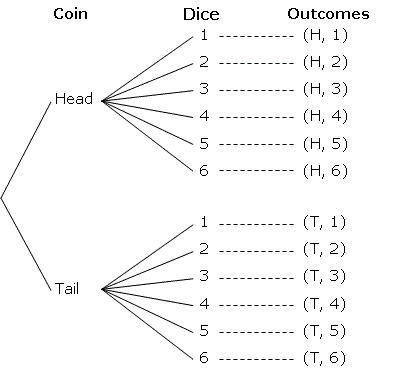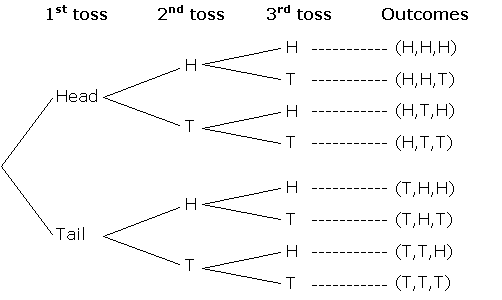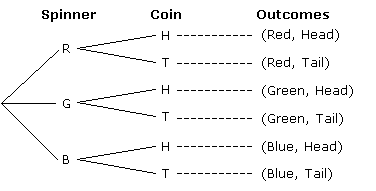Coin & Dice Probability: Using A Tree Diagram
In these lessons we will look at some examples of probability problems involving coins, dice and spinners. We will use tree diagrams to help solve the problems. We will see that tree diagrams can be used to represent the set of all possible outcomes involving one or more experiments.
Related Pages
More Tree Diagrams
Probability Tree Diagrams
More Lessons On Probability
Probability Worksheets
Example 1: Coin and Dice
Example:
A coin and a dice are thrown at random. Find the probability of:
a) getting a head and an even number
b) getting a head or tail and an odd number
Solution:
We can use a tree diagram to help list all the possible outcomes.

From the diagram, n(S) = 12
a) Let A denote the event of a head and an even number.
A = ((H, 2), (H, 4), (H, 6)} and n(A) = 3
![]()
b) Let B denote the event a head or tail and an odd number.
B = {(H, 1), (H, 3), (H, 5), (T, 1), (T, 3), (T, 5)}
![]()
-
Probability Worksheets
Printable
Probability (Equally Likely Outcomes)
Probability (Not Equally Likely Outcomes)
Probability Tree DiagramsOnline
Probability Problems
Complementary Probability
Probability Problems
Probability & Geometry
Mutually Exclusive Probability
Independent Events Probability
Dependent Events Probability
Example 2: Coins
Example:
Clare tossed a coin three times.
a) Draw a tree diagram to show all the possible outcomes.
b) Find the probability of getting:
(i) Three tails.
(ii) Exactly two heads.
(iii) At least two heads.
Solution:
a) A tree diagram of all possible outcomes.

b) The probability of getting:
(i) Three tails.
Let S be the sample space and A be the event of getting 3 tails.
n(S) = 8; n(A) = 1
P(A) = ![]()
ii) Exactly two heads.
Let B be the event of getting exactly 2 heads.
n(B) = 3
P(B) = ![]()
iii) At least two heads.
Let C be the event of getting at least two heads.
n(C) = 4
P(C) = ![]()
Example 3: Spinner and Coin
Example:
A spinner is labeled with three colors: Red, Green and Blue. Marcus spun the spinner once and
tossed a coin once.
a) Draw a tree diagram to list all the possible outcomes.
b) Calculate the probability of getting blue on the spinner and head on the coin.
c) Calculate the probability of red or green on the spinner and tail on the coin.
Solution:
a) A tree diagram of all possible outcomes.

b) The probability of getting blue on the spinner and head on the coin.
Let S be the sample space and A be the event of getting blue and head
n(S) = 6 ; n(A) = 1
P(A) = ![]()
c) The probability of red or green on the spinner and tail on the coin.
Let B be the event of getting red or green and tail
n(B) = 2
P(A) = ![]()
Coins And Probability Trees
Probability using Probability Trees.
Example:
A coin is biased so that it has 60% chance of landing on heads. If it is thrown three times, find the probability of getting:
(a) 3 heads,
(b) 2 heads and a tail,
(c) at least one head.
The following video gives more examples of probability involving coins and using tree diagrams.
You flip 3 coins. What is the theoretical probability of getting 2 heads and 1 tails?
Try the free Mathway calculator and
problem solver below to practice various math topics. Try the given examples, or type in your own
problem and check your answer with the step-by-step explanations.

We welcome your feedback, comments and questions about this site or page. Please submit your feedback or enquiries via our Feedback page.